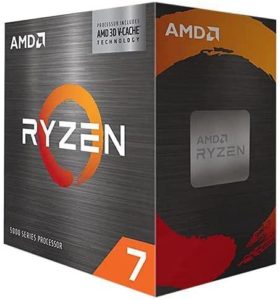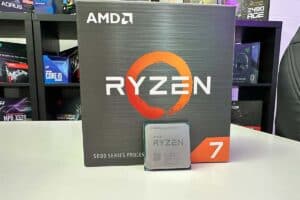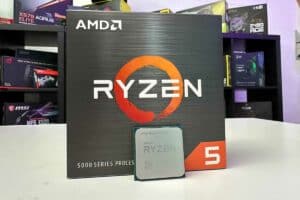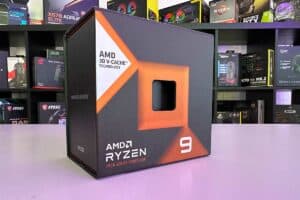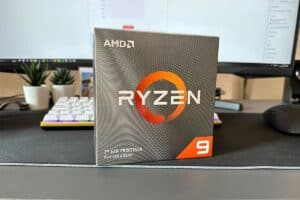AMD Ryzen 7 5800X3D review – the last AM4 CPU
We review the long-awaited Ryzen 7 5800X3D by analyzing its synthetic and real-world performance and determine the 5800X3D’s place in the market.
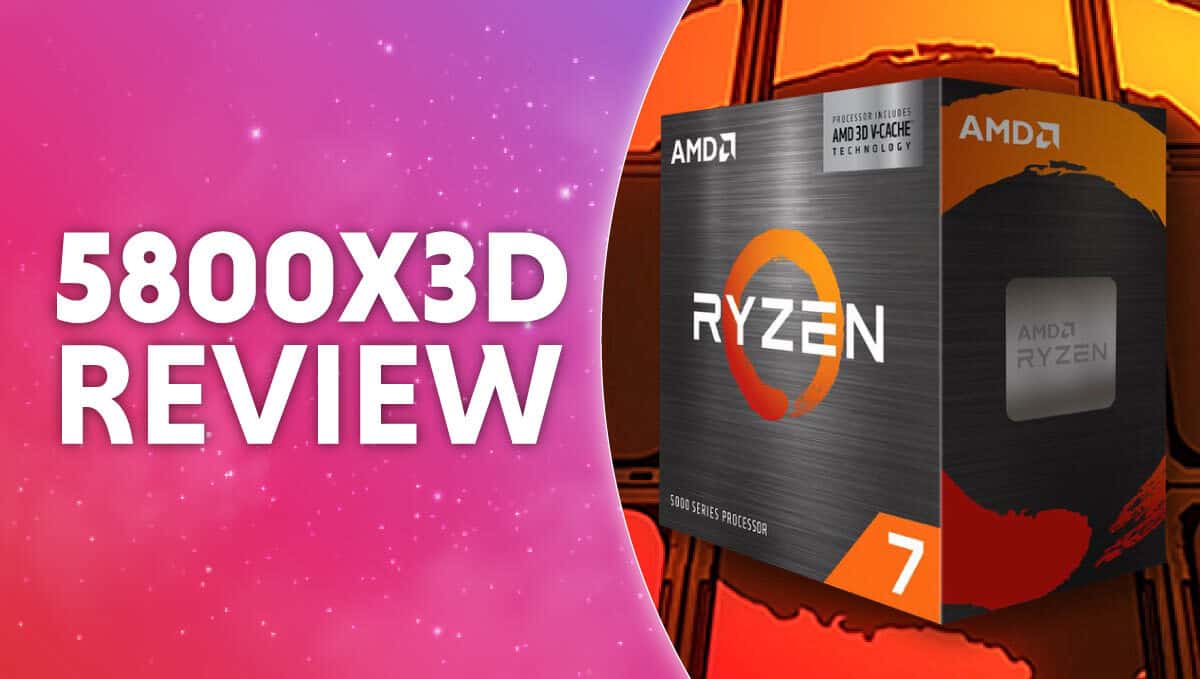
WePC is reader-supported. When you buy through links on our site, we may earn an affiliate commission. Prices subject to change. Learn more
AMD has just released its last AM4 processor, the Ryzen 7 5800X3D, and regardless of performance, it’s a pretty monumental moment for CPU enthusiasts everywhere. The Ryzen 7 5800X3D introduces a new caching technology, known as 3D V-cache. This isn’t a brand new technology, however, with Samsung’s V-RAND used in SSDs. We hope you enjoy our Ryzen 7 5800X3D review.
However, this is the first time we’re seeing it in a desktop CPU, and the inclusion of 3D V-cache technology is expected to give the 5800X3D a big edge. We’re here to put that to the test today, examining the 5800X3D’s performance in both synthetic and real-world workloads, and finally seeing how it stacks up against similar CPUs on the market. Spoiler alert: the 5800X3D is technically a very impressive beast.
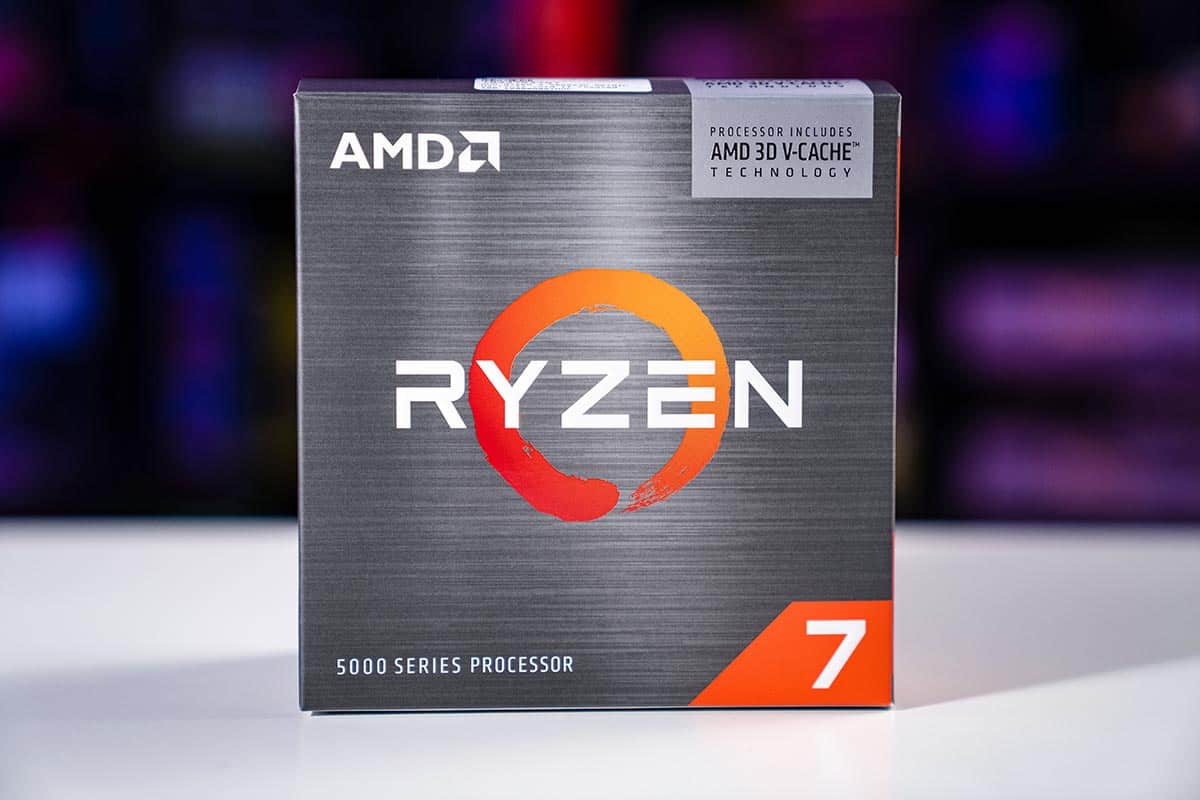

AMD Ryzen 7 5800X3D
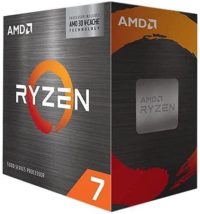
Cores
8
Threads
16
Max boost speed
4.5GHz
L3 Cache
96MB (64MB 3D V-cache)
TDP
105W
If you would like to know about Zen 4 and AM5, we have dedicated articles on those.
VS pieces
Here are some of our ‘VS pieces’ involving the 5800X3D:
Ryzen 7 5800X3D specifications.
The specifications of the Ryzen 7 5800X3D are very similar to the base model Ryzen 7 5800X, just with a lower base and boosted core frequencies and the inclusion of 64MB 3D V-cache.
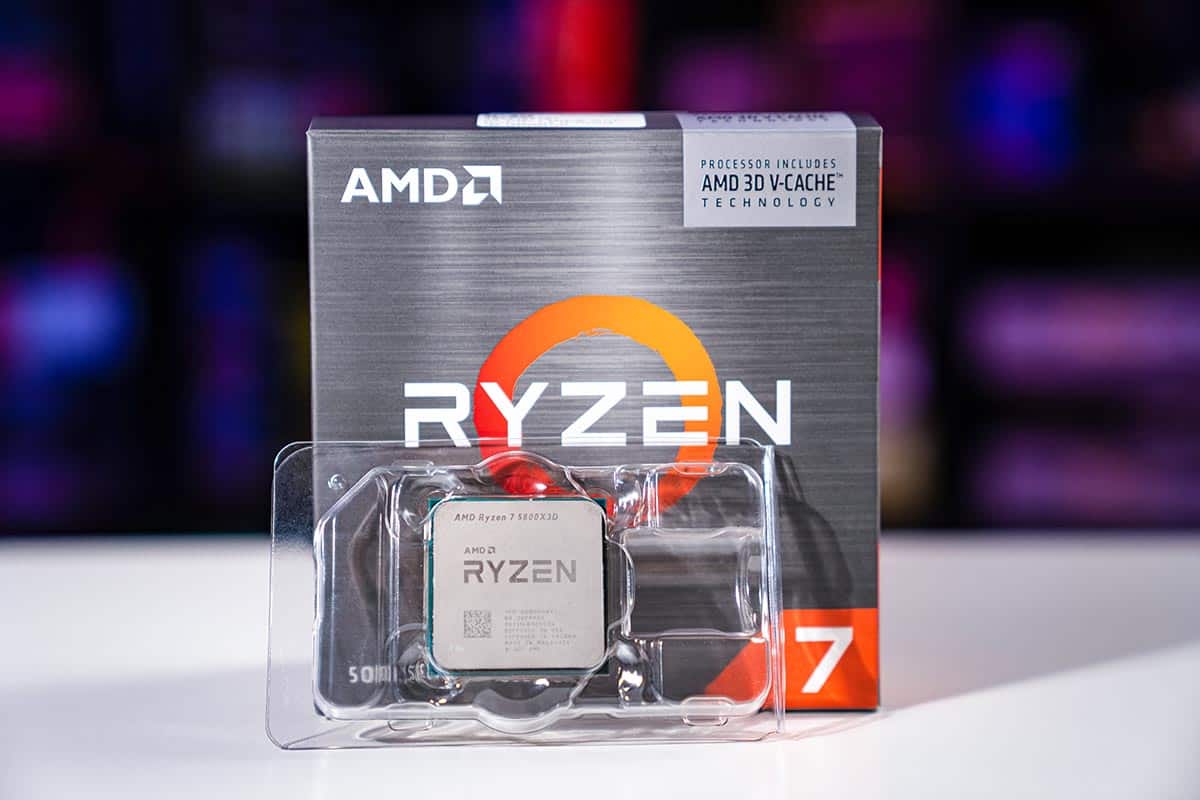
The original Ryzen 7 5800X runs at 3.8GHz with a 4.7GHz boost clock, while the 5800X3D runs with a 3.4GHz base and 4.5GHz boost clock, at lower voltages (1.35v instead of 1.5v). The lower voltages are most likely so the CPU will be more stable at lower clock speeds. This is also the reason AMD canned overclocking support for the 5800X3D, although there have been some reports suggesting that tweaking base clock speeds result in better performance.
The specifications of the Ryzen 7 5800X are as follows:
- Cores: 8
- Threads:16
- Base clock speed: 3.4GHz
- Max boost speed: 4.5GHz
- Total L1 cache: 512KB
- Total L2 cache: 4MBs
- Total L3 cache: 96MB (64MB 3D V-cache)
- Default TDP 105W
- TSMC 7nm FinFET
- Socket: AM4
- Memory type: DDR4
Before we take a deeper dive into the 5800X3D it’s important to understand what 3D V-cache is and why it’s so damn impressive.
2D cache vs 3D V-cache
2D cache (the standard cache that comes with today’s CPUs) is stacked laterally with smaller silicone dies allowing for more space for each cache chiplet. The issue with each cache chiplet being laid across one layer is the massive surface area requirements, severely limiting the number you can fit into a certain footprint. But with 3D cache that all changes.
3D cache is not stacked laterally but vertically (thanks to new 3D printing technology) – hence the term 3D cache. This drastically increases the number of chiplets you can cram into an area of any given size, thus resulting in larger cache capacities without sacrificing access speeds. The vertical stacking allows AMD to achieve the massive 96MB L3 cache with a total access speed of 2TB/s in its 5800X3D CPUs. The massive capacity is achieved by layering two layers of 48MB cache on top of each other.
This has all been made possible thanks to AMD’s close relationship with its chiplet manufacturer TSMC, allowing them to formulate a CPU using a new 3D packing technique, allowing the cache to be stacked on top of the 5800X3D’s Core Complex Die (CCD), while using a hybrid bonding approach that mixes copper-to-copper bonding with through-silicon vias (TSVs), that allows the Zen 3 CPU cores and L3 cache to communicate and exchange data seamlessly.
Despite the 3D cache stacking, the actual Zen 3 CCD manufacturing process has been slimmed down, allowing the 5800X3D the same form factor and retaining compatibility with all AM4 coolers as well as AMD’s own AM4 CPU IHS. This is one of the reasons the 5800X3D runs hotter than the 5800X, but we’ll get to that later.
Ryzen 7 5800X3D price
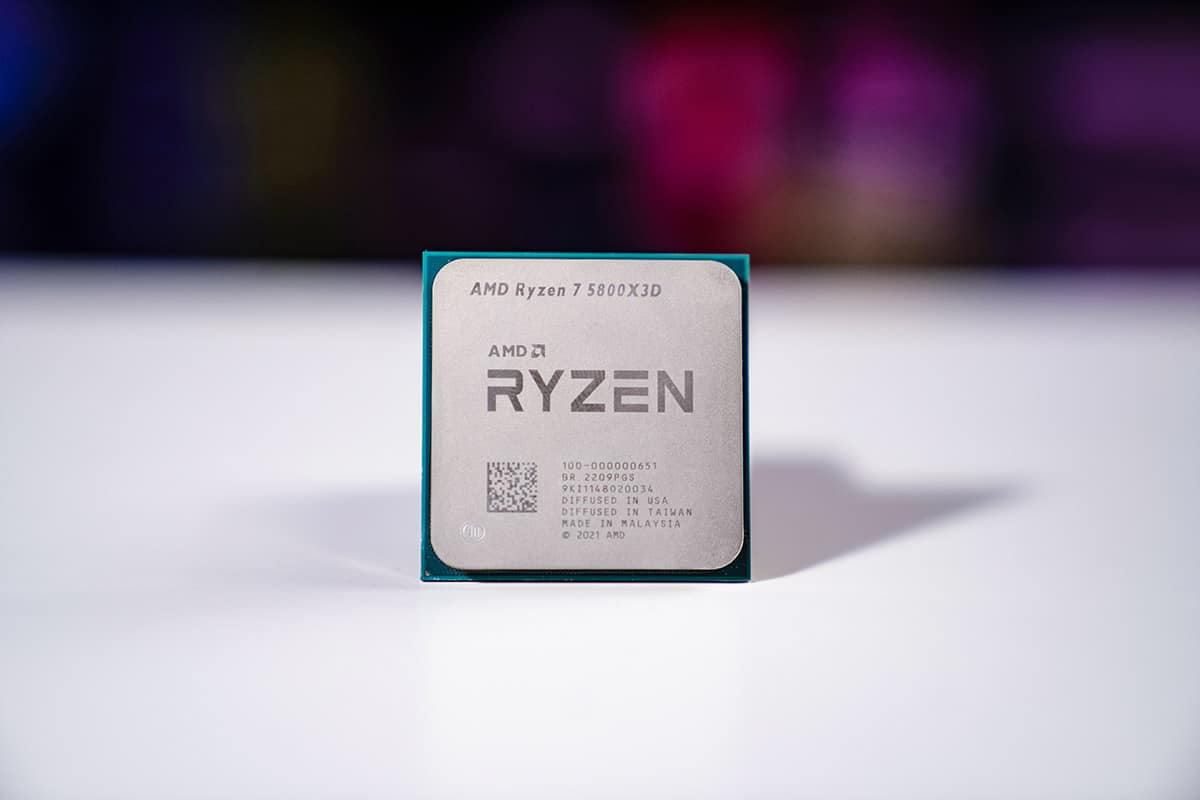
The Ryzen 7 5800X3D was released on April 20 at a price of $449, with a cost per core of $56. That’s definitely more expensive than a 5900X, which can be found for around $350.
The 5800X3D is almost half the price of Intel’s brand new 12900KS which retails at $799, but that does perform significantly better in synthetic benchmarks.
$449 is not really a steep ask for a brand new CPU in 2022, but if it doesn’t outperform less expensive CPUs then it’s not going to look good for the 5800X3D.
5800X3D performance
We’ll be pitting the 5800X3D primarily against the 5800X and 12900K in this Ryzen 7 5800X3D review, but sprinkling in some 12900KS where it seems appropriate. We performed both synthetic and real-world benchmarks on the 5800X3D in order to determine its value in the market and its use case. Or more importantly, how it stacks up against similar CPUs on the market.
Is the 5800X3D a fitting last defender of the legendary AM4 platform? Let’s find out.
5800X3D synthetic benchmarks
We tested the Ryzen 7 5800X3D in five synthetic benchmarks: CPU-Z, Cinebench R23, Geekbench 5, Blender 3.1.0 and 3DMARK TimeSpy Extreme.
Cinebench R23
Cinebench has been a reliable CPU rendering benchmark for many years and is a favourite among PC enthusiasts. We have chosen Cinebench for its raw rendering pressures and extensive databanks.
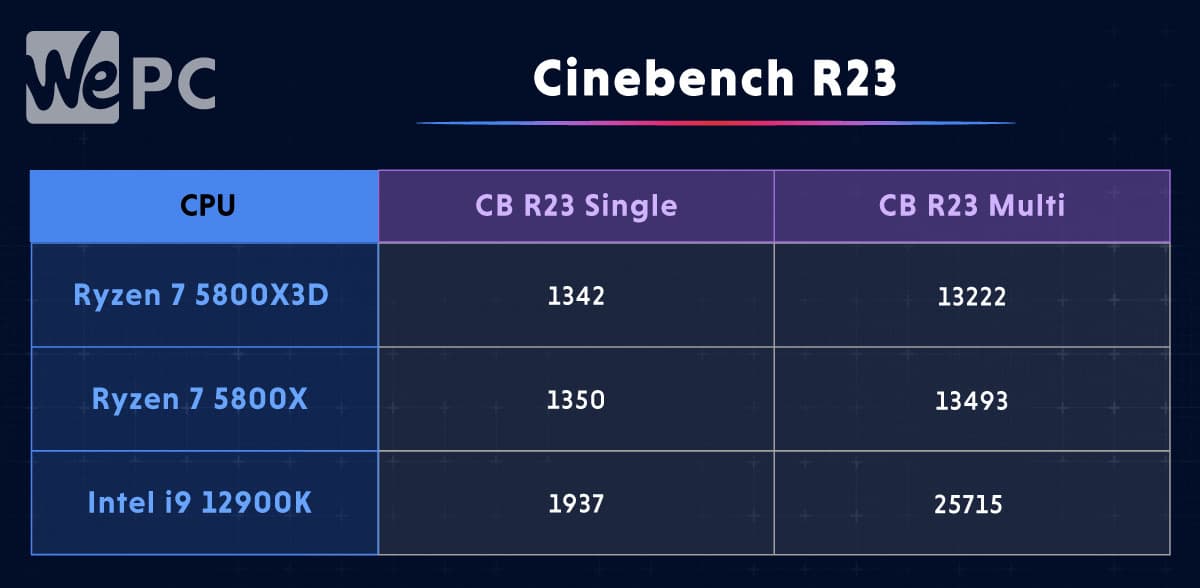
Single-Core
As you can see in this Ryzen 7 5800X3D review, the Ryzen 7 5800X3D scores 1,342 points in Cinebench’s single-core benchmark. That’s marginally less than the 5800X, which scores 1,350 points. The 12900K obliterateds both with a single-core score of 1,937.
Multi-Core
The Ryzen 7 5800X3D manages a multi-core score of 13,222. This score is beaten by both the 5800X and the 12900K, with scores of 13,493 and 25,715 respectively. The 5800X3D score is likely due to the lower clock speeds and the lack of AMD PBO support, narrowly allowing the 5800X victory over the 5800X3D.
So, it looks like the new 3D V-cache makes little difference in rendering heavy workloads.
Geekbench 5
Geekbench 5 is a very sophisticated benchmark that tests a CPU’s performance as close to a real-world use-case as possible, benchmarking components such as text compression, floating-point, image compression and HDR. These are all calculations that a CPU does in many day-to-day tasks. Geekbech then outputs a score based on the CPU’s performance.
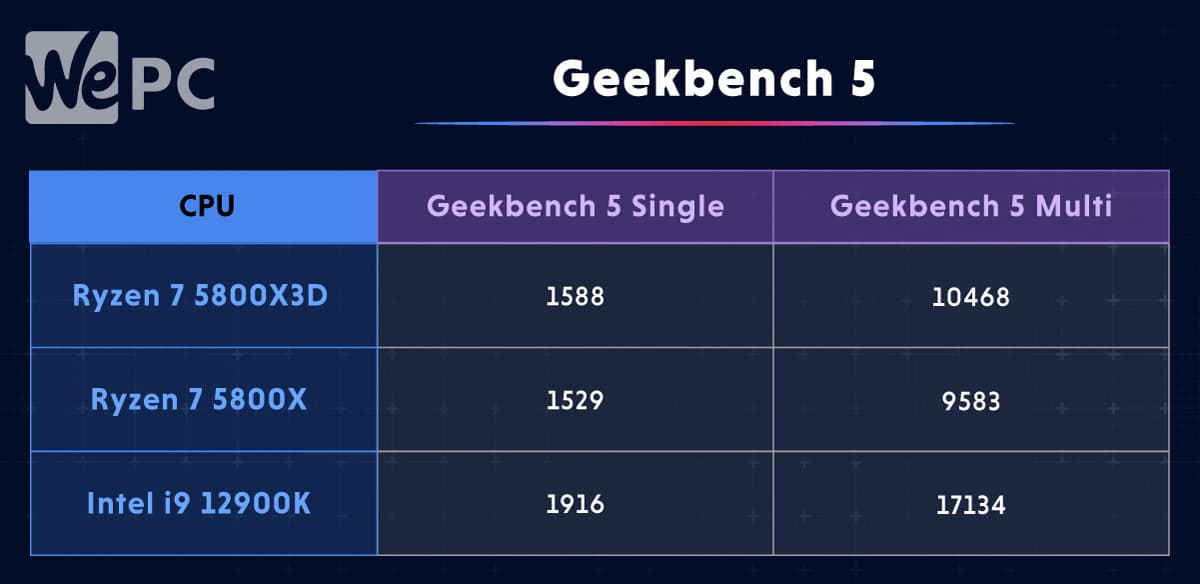
Single-Core Benchmarks
It’s a different story in Geekbench however, where the 5800X3D manages to score a reasonable 1,588 points, beating the 5800X which scored just 1,529 points. But again the 12900K demolishes the 5800X3D with a single-core score of 1,916 points.
Multi-Core Benchmarks
It’s a similar story in the Geekbench multi-core benchmarks – the 5800X3D scored 10,468 points, beating out the 5800X which scored 9,583 points, but falling yet again to the 12900K which scored 17,134 points. It looks like Geekbench and its more ‘true to life’ synthetic benchmarks make better use of the new 3D v-cache.
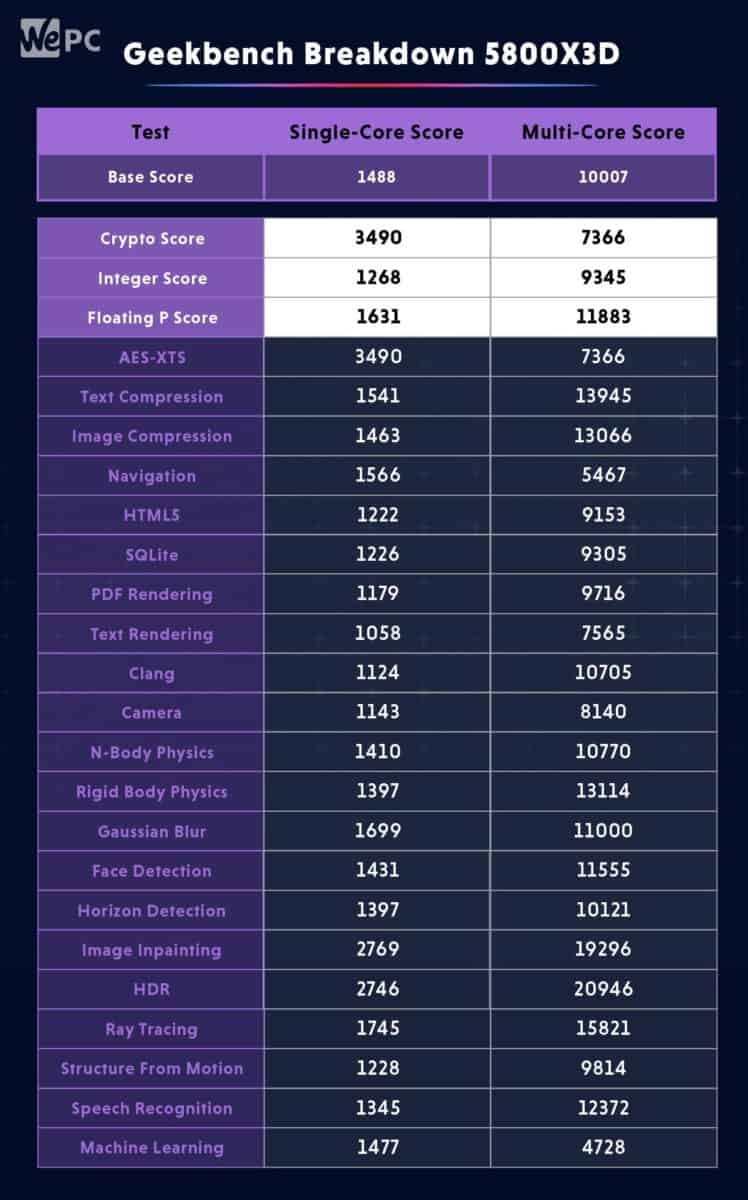
This is the full breakdown of both the synthetic single-core and multi-core Geekbench 5 benchmarks.
Geekbench 5 5800X3D vs 12900KS
Just for fun, these are the in-depth results of the Geekbench 5 benchmarks for both the 5800X3D and the 12900KS. And as you can see, it’s really no contest. It’s interesting to see just how overkill Intel decided to go when releasing the 12900KS to combat the 5800X3D. Thankfully for AMD, performance isn’t everything.
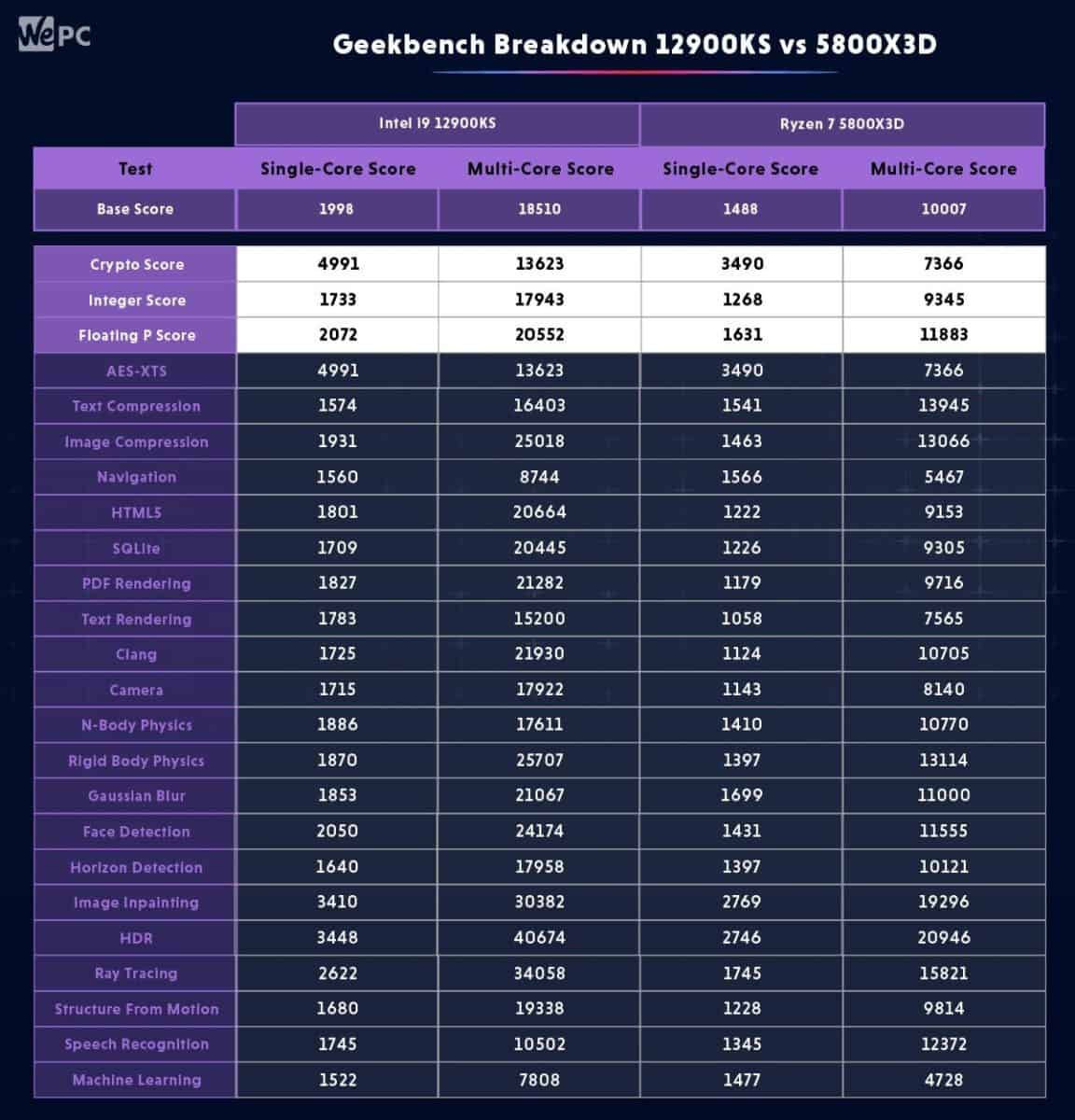
For this Ryzen 7 5800X3D review it should be noted, however, that the 5800X3D does not support DDR5 RAM, unlike the 12900KS. RAM is a huge factor in CPU performance, and this is especially true for Ryzen CPUs, as core communication speed is directly correlated with RAM speeds. Further testing is required to see if the 5800X3D manages to keep up on a more equal footing.
This is certainly not the 10% performance increase over the 12900K AMD spoke about when they revealed the 5800X3D. Hopefully, we will see an improvement in performance as we move forward.
It does make you appreciate the amount of power behind the 12900KS, and if you’d like to know more about this, we have written a full review of it.
CPU-Z
CPU-Z is a tool that has its own reliable built-in benchmark software. CPU-Z is used by millions around the world and its benchmark software is becoming increasingly popular.
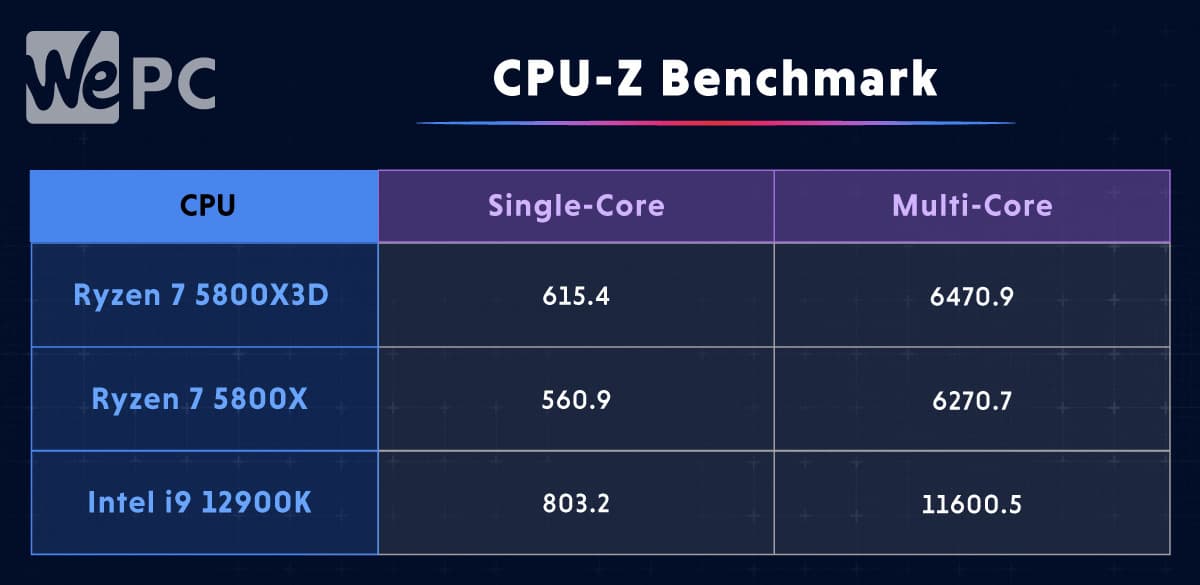
Single-Core benchmarks
Finally, the 5800X3D is starting to pull away from the 5800X in terms of performance, scoring a respectable 615.4 points in the single-core benchmarks. This is a sizable lead over the 5800X which scored 560.9 points but again, nothing compared to the 12900K’s 803.2 points.
Multi-Core benchmarks
The 5800X3D again scores ahead of the 5800X, with scores of 6,470.6 and 6,270.7 respectively. That’s a very respectable lead considering on paper the 5800X3D is the lesser processor. Unfortunately, however, it’s no match for the 12900K’s score of 11,600.5 points.
Blender 3.1.0
Blender is an extremely popular 3D modelling and rendering software used by prestigious animation and SFX studios around the globe. Blender is capable of creating incredibly demanding 3D scenes in its rendering benchmark, ‘Blender Open Data’.
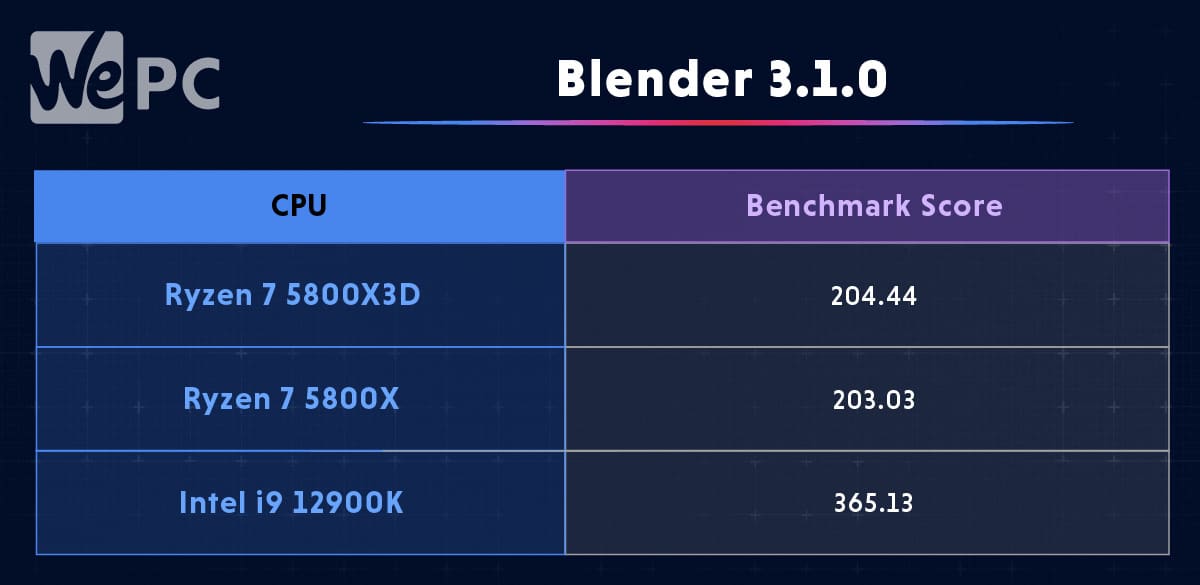
Again the 5800X3D secures a lead over the 5800X, but not by much, with the 5800X3D scoring 204.44 points and the 5800X scoring 203.03 points. And yet again, the 12900K comes blazing through with a score of 365.13 points. That’s a very impressive score from the 12900K.
The 5800X3D seems to really be struggling with the synthetic benchmarks against the 12900K but holding its ground against the 5800X.
3DMARK Timespy.
Timespy is a synthetic benchmark for gamers looking to put their PC through its paces. It’s essentially a 3D rendering sequence rendered in real-time, with elements you’d commonly find playing games in a real-world scenario. It is important to remember, however, that it’s still a synthetic test, meaning results will not be as true to life as an actual real world test.
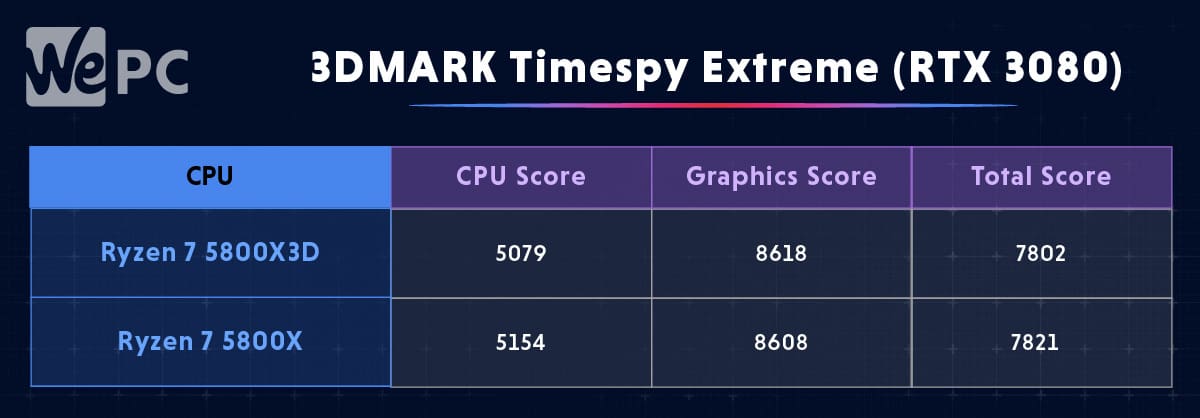
As you can see, in this Ryzen 7 5800X3D review the results in Timespy are a little divided. Timespy extreme measures CPU and GPU performance and gives a total score based on the other two totals. These scores for the 5800X3D are as follows:
The 5800X3D scored a respectable 5,079 points in the CPU benchmark and 8,618 points in the GPU benchmark, This totals a score of 7,802. However, the 5800X did manage to nip in front of the 5800X3D with scores of 5,154 and 8,606 respectively, amassing a total score of 7,821, just 18 points ahead of the 5800X3D.
Synthetic benchmark summary
It looks like the 5800X3D is struggling to stay ahead of the 5800X consistently. This is most likely due to the 5800X3D’s lower base and boosted clock speeds.
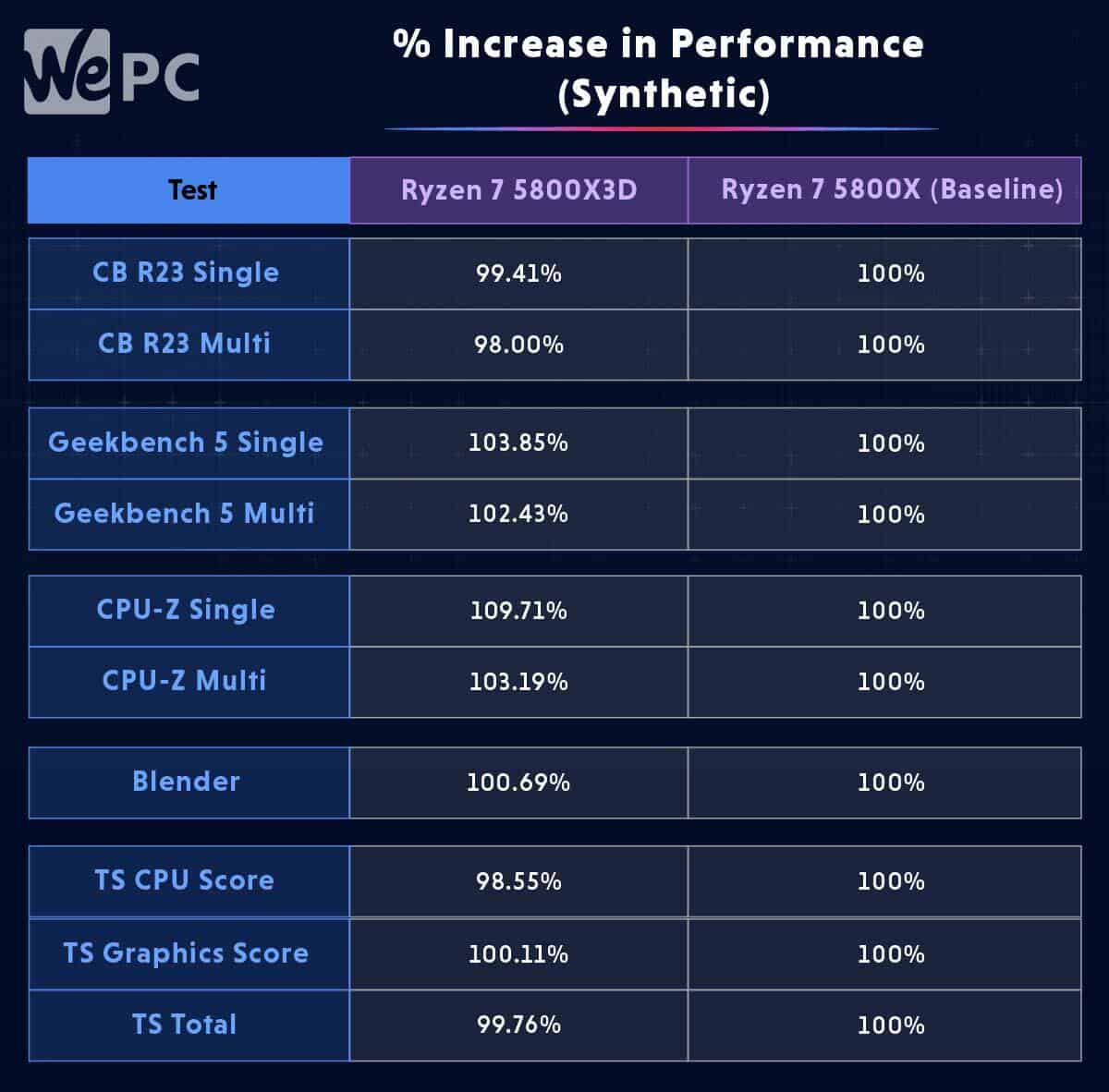
With performance percentiles ranging from -2% to +9.71% you can clearly see the 5800X3D struggling, especially in Cinebench multi-core workloads, but it’s still fairly impressive that it’s managing to keep up at all regardless of its lower clock speeds.
Cache rarely has an impact on synthetic benchmarks due to their limited instruction sets, and with the 3D V-cache being the 5800X3D’s saving grace, it’s unable to fully spread its wings. Will the real-world benchmarks be better?
5800X3D real-world benchmarks
We tested the 5800X3D in two games, along with the 5800X and 12900K, we will be adding more to the arsenal of games though so stay tuned for even more glorious data. The games we used are Days Gone and the infamous system-killing Cyberpunk 2077.
The test bench we used for the 5800X3D and 5800X consisted of an Aorus PRO X570, 32GB DDR4 @3600MHz and an MSI Gaming-X Trio RTX 3080.
The test bench for the 12900K had to differ due to motherboard compatibility. This test bench consists of an ASUS ROG Z690, 32GB of DDR5 5600MHz RAM and an MSI Gaming-X Trio RTX 3080.
So, automatically the 12900K has a huge advantage. But will it be enough to subdue the 5800X3D’s 3D V-cache technology?
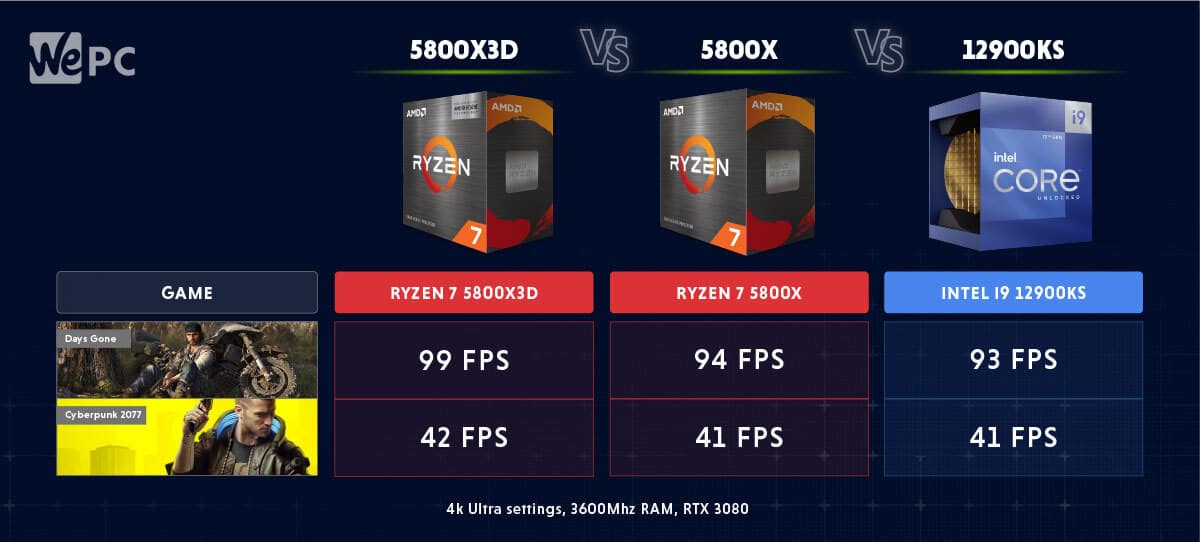
Days Gone
Days Gone is a relatively demanding game when having to rely on older hardware to run it. , It has been ported to the PC and rebuilt for the platform on the latest Unity engine, adding lots of features the console version lacks. We tested Days Gone at 4K, at maximum settings.
The 5800X3D is a clear winner here, scoring an average FPS of 99FPS in 4k max settings. This is ahead of both the 5800X and the 12900K, which scored FPS averages of 94 and 93FPS respectively. It’s an impressive feat and we’re definitely seeing AMD’s accelerated 3D V-cache kicking in here in real-world benchmarks.
The gameplay seems smoother on the 5800X3D too – where the 5800X and 12900K would normally stutter slightly, the 5800X3D seemed to keep its cool and stutter the least of the three CPUs.
Cyberpunk 2077
Cyberpunk is an unforgiving game, especially at higher settings and resolutions, so we decided to test it at 4k max settings for maximum pain. The 5800X3D actually comes out on top again with a single FPS lead on both the 12900K and the 5800X. The 5800X3D averaged 42FPS whilst the other two CPUs tied with 41FPS.
It doesn’t seem like much but one FPS is usually the difference you see in Cyberpunk. With the 3080 all maxed-out any performance headroom can only be gained by upgrading the CPU.
Again gameplay seemed smoother than the 5800X and 12900K with less stuttering overall and fewer less drastic dips in FPS. Cyberpunk has a habit of tanking the FPS for a second when entering an intense scene, but not with the 5800X3D.
1080P gaming performance
When removing the GPU bottleneck and running games at 1080P we can see the 5800X3D gain a substantial lead over the 12900K in most games. The games that seem to favour the 12900K are ones that rely more heavily on single core CPU performance, as the 12900K can reach boost speeds 0.7GHz higher than the 5800X3D.
The 12900K as we previously mentioned also has access to much faster DDR5 memory, bolstering the performance in some workloads that favour core speed over number of cores.
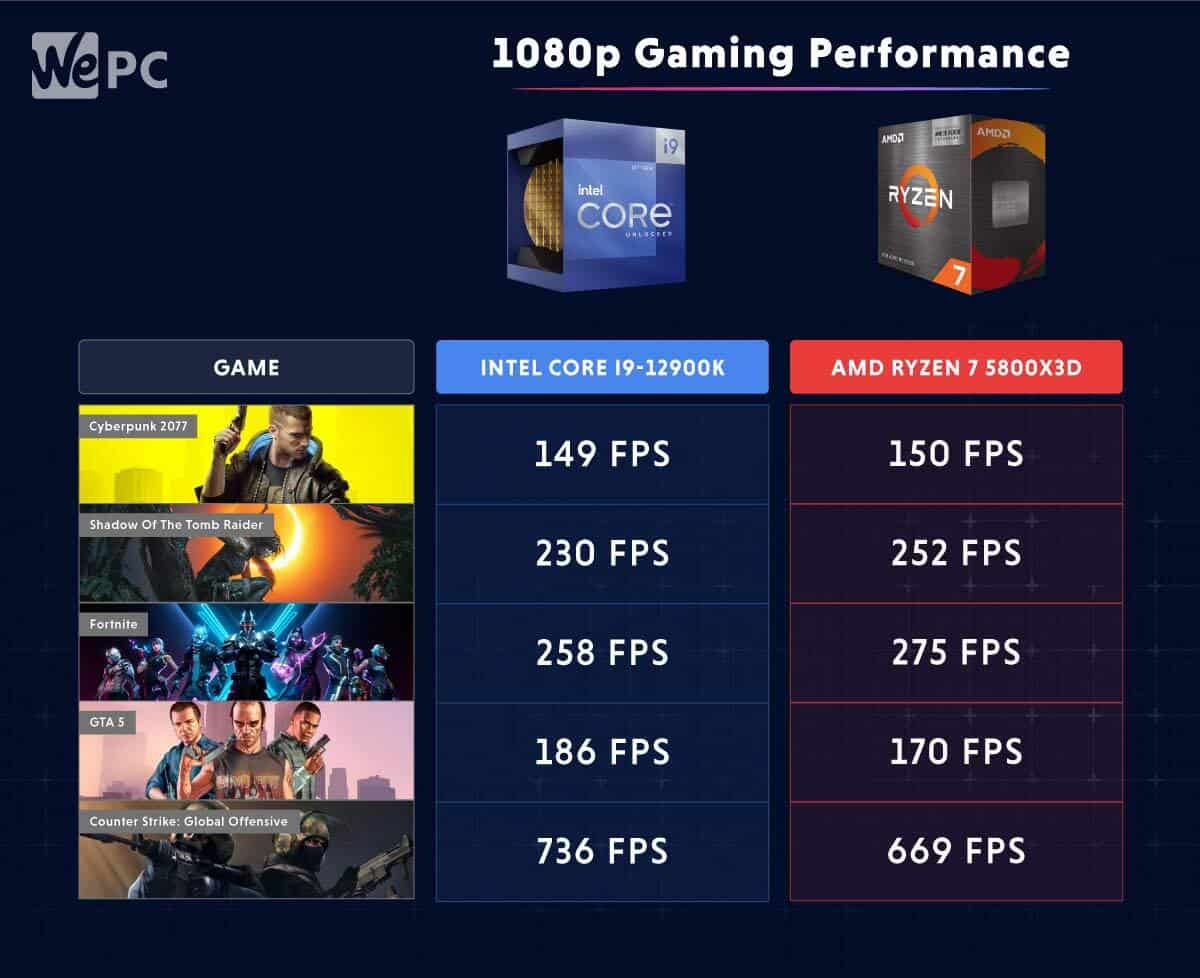
The 5800X3D is an incredibly powerful CPU, considering the limited technologies it has to utilize in comparison to Intel’s 12900K. Here is where AMD’s 3D V-cache really shines through giving a boost in gaming never before seen on the AM4 platform.
Real-world performance summary
The 5800X3D really held its own in our preliminary testing, holding off the 12900K and the 5800X in a pretty big way. The 3D V-cache is really pulling its weight in real-world benchmarks. It just goes to show what an improvement a larger, faster cache can make when organizing CPU instructions for gaming.
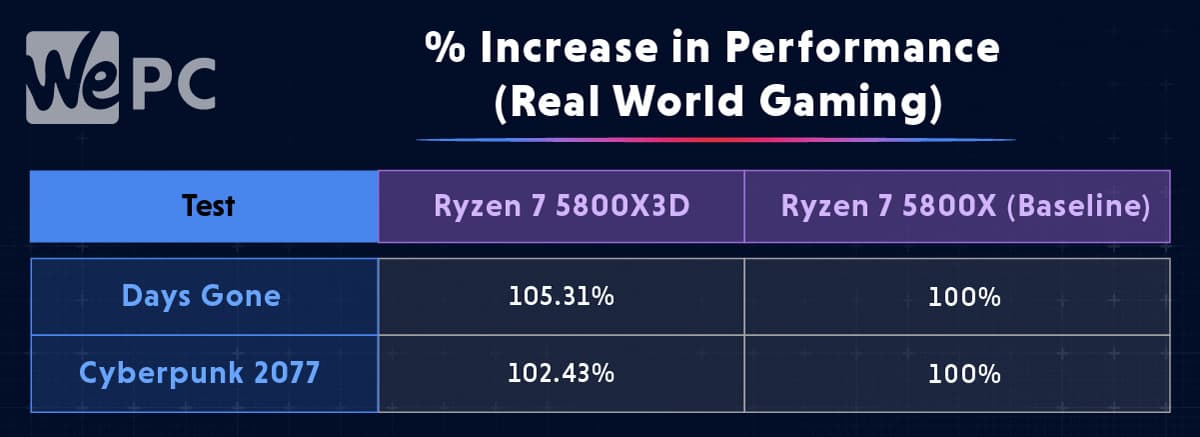
If we use the 5800X as a baseline in this Ryzen 7 5800X3D review, we can see the 5800X3D is 5.31% better than the 5800X in Days Gone and a respectable 2.43% faster in Cyberpunk2077. These metrics don’t seem like much but when you take into consideration the 5800X3D’s reduced clock speed. It becomes a little more impressive.
The 5800X3D runs hot!
At the top of the article, we briefly discussed the packing technology used to create and infuse the new 3D V-cache to the 5800X3D’s CCD. By slimming the process and making the CPU compatible with the old IHS, it’s causing some thermal issues.
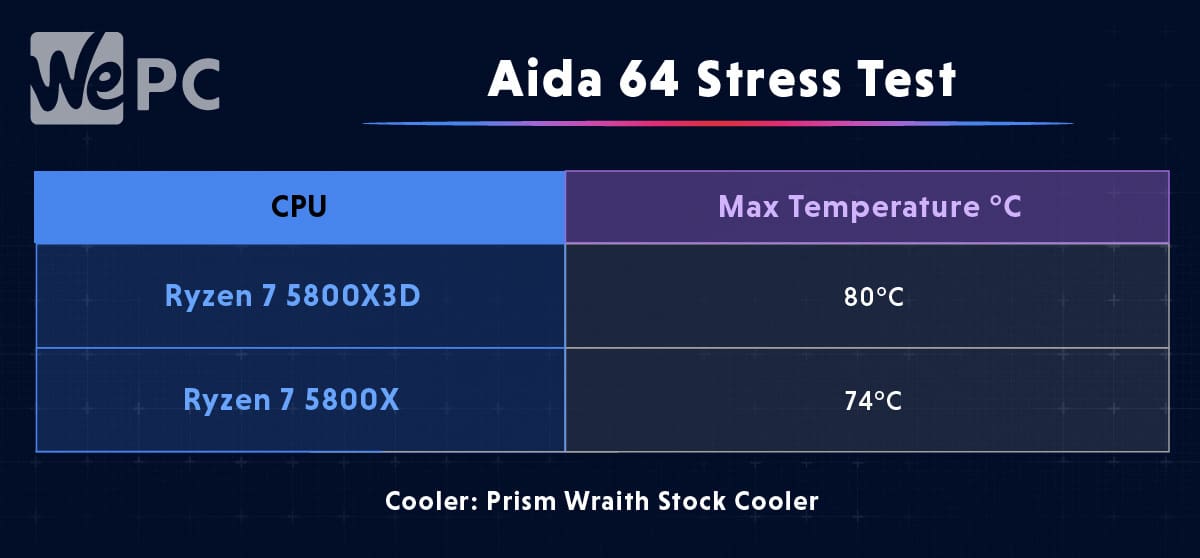
During an Aida64 stress test, we used a Wraith Prism AMD stock cooler just for fun to determine the temperature increase this 3D cache will have on the CPU, given the fact they’re basically the same CPU, just the 5800X3D has lower clock speeds and a different cache.
The results we found were that during our testing, the 5800X3D runs around 6°C hotter than the base 5800X. So, if you upgrade to the 5800X3D, you are going to need to make sure you have the thermal headroom with your cooling solution to do so.
Pros and cons
Wondering whether or not to get yourself a 5800X3D? We’ve wrapped up a handy list of pros and cons in this Ryzen 7 5800X3D review to let you know whether or not this new CPU is up to scratch.
Pros
- Game performance surpassing i9-12900K
- Inexpensive
- No motherboard upgrade required
- A big boost in gaming from 3D V-cache
Cons
- Lower clock speeds result in bad single-core performance
- AM4 offers no upgrade path.
The 5800X3D was always a bit of an experiment, AMD saw the opportunity to make advancements in the world of 3D V-cache and chose the end of AM4 to do it. Needless to say, we think the experiment was a huge success.
Final word
The 5800X3D is a very interesting CPU, with clock speeds and up-on cache, with more technology than ever packed under that old IHS. In synthetic benchmarks, the 5800X3D doesn’t do so well, due to its lower base and boost speeds and the fact that it does not support overclocking. There was barely a performance uplift from the 5800X in some benchmarks, and we often see it scoring lower than the 5800X. That’s because where the 5800X3D lacks in speed it makes up for in cache and instruction processing.
The 3D V-cache cannot be tested properly in a synthetic environment, that’s why the 5800X3D’s performance in synthetics is mediocre at best, but so great in real-world scenarios.
In the real world, the 5800X3D slams both the 5800X and the 12900K, especially in Days Gone. where the CPU can really stretch its wings and perform, unburdened by the linearity of synthetic benchmarks.
The 5800X3D performs around 5% better than the 5800X on average in our synthetic benchmarks and around 3% better than the 12900K in real-world benchmarks according to our data. Now that is impressive. Is the extra heat energy generated justifiable for a performance uplift over the 12900K? If you ask us, absolutely!
Time to talk price. The 5800X3D comes in with an RRP of $449, which is pretty good, especially compared to Intel’s latest CPU the 12900KS, which comes in at $799.
The i9-12900K has been out for a year or so now, meaning you can find it for a little less than retail. After shopping around, we found the average price to be around $510 for the 12900K. Still, that’s a good $60 over the 5800X3D, and the 5800X3D even performs a little better for less money.
Speaking of performing better for less money, the Ryzen 9 5900X can be had now for around $360 and will perform better than the 5800X3D due to its extra cores and higher clock speed.
The 5800X3D is an amazing CPU and a beautiful feat of technical ingenuity. No matter where you go there’s usually something that will perform better for less money when speaking of brand-new releases. The trouble with this CPU is that AM4 is basically dead, with a non-existent upgrade path ahead you’re going to be stuck on the 5800X3D until you upgrade to AM5.
Is this a good CPU? Absolutely! Do we wish it came sooner in AM4’s life cycle? You Bet! Should you get it? If you’re not bothered about sticking with AM4 for the next few years then go for it!

AMD Ryzen 7 5800X3D
